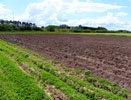Services
Solutions
Fulltext
The Lopušné-Pažite Deposit
This deposit of non-reserved mineral (building stone) forms part of the Malé Ostré elevation that is located above the 460 m asl. contour line. The geological processes that formed this elevation gave it the shape of an outlier that morphologically prominently protrudes from the surrounding shaley formations. The western and northern slopes rise steeply from the valley bordering the streams (with Vadičovský Stream constituting the northern border and with an unnamed watercourse at the western border), which also form the local base-level of erosion with the hydrographic head from 450 to 400 m asl. The ground slope of the elevation is 45°. The slopes of the northern and the western sides are terminated by a sharp summit ridge of a NW-SE direction, while the entire area is covered by a mixed deciduous forest. The total elevation of Malá Ostrá from the local base-level of erosion is 185 m.
The greatest thickness of the raw material is 75 m (on the narrow summit ridge-line of Malá Ostrá), with an average thickness of 38.7 m. In fact, the raw material can be found even below this level, where, with respect to the condition of the deposit, it is possible to anticipate an analogous development of the layers.
The following units occur within the expanded area of the deposit from north to south: the northernmost is the Palaeogene of the Bystrická unit, followed by the inverted, almost complete, strata sequence of the Kysucká series of the klippen zone (Alen to Lower Mastricht), sloping steeply to the north. Further to the south (in the zone north of Žilina that is bordered by dislocation lines), an upper unit of the klippen zone occurs that is characterised by the development of the Manín series (Upper Aptian - Santon). The southernmost unit that is also adjacent to the klippen zone is the Hričovsko-Podhradský Paleogene of the Ilerd - Lower Priabon period.
The evaluated deposit comprises part of the klippen zone of the Kysucké Hills in association the development of the Kysucká series, which has the specific relief of the structural and erosional forms of an outlier. Malá Ostrá is one of the numerous limestone outliers that are located at the western end of this mountain range.
Involved in its geological structure are Cretaceous and Jurassic sediments in a reverse sequence of the strata. From south to north these are:
- shaley calcareous siltstone to argillaceous limestone with inserts of fine-grained to mottled limestone, belonging to the koňhorské layers of the Aptian age; this series of strata constitutes the southwest end of the deposit and was classified as belonging to the koňhorské layers based on its analogous lithological development,
- cherty mottled integral to fine-grained limestone of the Lower Cretaceous (Neokom) with numerous shaley inserts (that are particularly present in the upper layers of the formation), which on the northern edge of the deposit may gradually be mixed with the Tithonian limestone,
- Calpionellous pale grey and pale green-grey Tithonian limestone,
- red nodular Kimmeridge limestone occurs locally in thin middlings as their folded position.
In regard to the geological structure of the deposit area the Neokom limestone formation has the decisive representation.
From a qualitative point of view, the main type of raw material in the deposit is the limestone that is intended for the production of crushed stone (i.e. raw material of type I). In the southeast of the deposit the limestone that emerges is significantly imbued with claystone, clayey limestone, clay-calcareous siltstone (i.e. raw material of type II), which, under certain conditions, is usable, for example, for backfilling, for constructing embankments and also as a reclamation material.
The utility raw materials from the deposits are limestone rocks from three stratigraphic levels. From the petrographic aspect and also in terms of its qualitative properties the limestone rocks constitute a single utility material. This material is mainly represented by mottled cherty limestone of the Lower Cretaceous (Neokom) period, which, in accordance with its lithological development and geological condition, may be mixed at the northern end of the deposit with the Calpionella type of Tithonian limestones.
The raw material is deposited in the geological strata of various differing slopes and courses. It is thinly to medium-banked, gradually mostly becoming medium-banked and it is often also tectonically faulted. Its faulted sections naturally disintegrate into gravel fragments of different sizes; otherwise into flat fragments or into blocks with a thickness that corresponds to that of the geological layer (i.e. the bank).
The geological layers are deposited in steep, erect and inverted folds with the general W-E course and the inclination to the north. The various strata are intensively, sometimes even in detail, folded. Various forms of folds (narrow, steep or erect, upright “S” folds, wedge-shaped, flat, horizontal to inverted, minor faulted overfolds or the closed narrow cores of folds) can be observed in the quarry’s walls. The layers generally have an E-W direction with their inclination usually towards the north (while in their normal position it would be to the south). The variability of the details of the direction and the slope of the layers is significant; in some flanks of folds the directional deviation is as high as 90°, with the inclination of the layers being between 5° (rarely) and even up to 80° - 90°, though usually it will be between 30° and 70°. The geologically later (koňhorské) layers of the deposit are actually frequently in the position of the geological bedrock, while the earlier layers constitute the caprock and act as tectonically reduced residues (i.e. the cores of small folds) in a geologically younger formation. The inversion of the sequence of layers is the result of the extensive folding activity that took place and caused the significant disruption of the rocks located on the deposit area. The manifestation of the primary instability during the deposition of the rocks is related to the numerous shaley and clayey middlings that either constitute or fill-in the interlayer positions in the limestone.






























